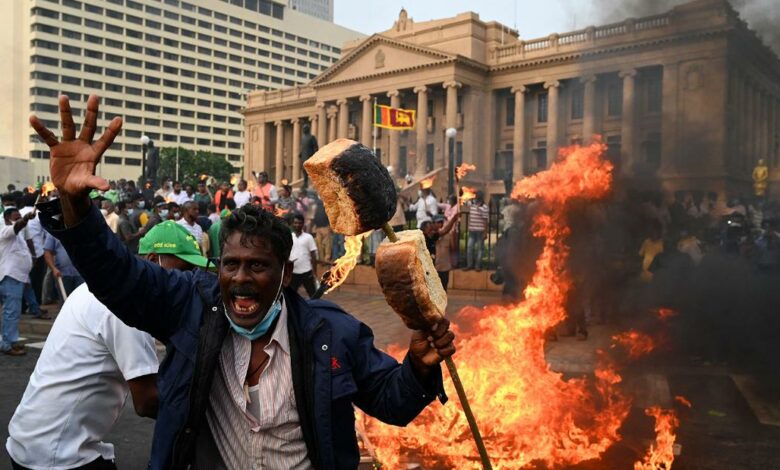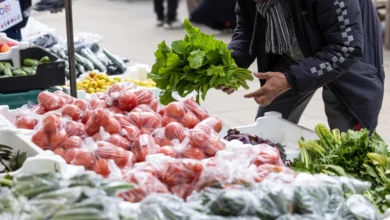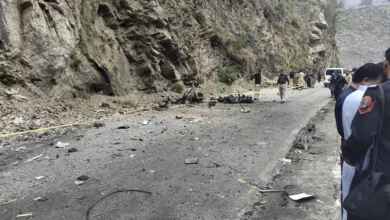
London (CNN Business) – When people took to the streets in Egypt in 2011, protesters chanted about freedom and social justice — but also bread. The cost of pantry staples had jumped because of the skyrocketing price of goods like wheat, stoking fury with President Hosni Mubarak.
Now, more than a decade after the Arab Spring, global food prices are soaring again. They had already reached their highest level on record earlier this year as the pandemic, poor weather and the climate crisis upended agriculture and threatened food security for millions of people. Then came Russia’s war in Ukraine, making the situation much worse — while also triggering a spike in the cost of the other daily essential, fuel.
The combination could generate a wave of political instability, as people who were already frustrated with government leaders are pushed over the edge by rising costs.
“It is extremely worrisome,” said Rabah Arezki, a senior fellow at Harvard’s Kennedy School of Government and former chief economist at the African Development Bank.
Unrest in Sri Lanka, Pakistan and Peru over the past week highlights the risks. In Sri Lanka, protests have erupted over shortages of gas and other basic goods. Double-digit inflation in Pakistan has eroded support for Prime Minister Imran Khan, who is clinging to power. At least six people have died in recent anti-government protests in Peru sparked by rising fuel prices. But political conflict isn’t expected to be limited to these countries.
“I don’t think people have felt the full impact of rising prices just yet,” said Hamish Kinnear, a Middle East and North Africa analyst at Verisk Maplecroft, a global risk consultancy.
Lessons from the Arab Spring
In the run-up to the anti-government protests that became known as the Arab Spring — which began in Tunisia in late 2010 and spread through the Middle East and North Africa in 2011 — food prices were climbing sharply. The Food Price Index from the United Nations’ Food and Agriculture Organization reached 106.7 in 2010 and jumped to 131.9 in 2011, then a record.
“Mohamed Bouazizi didn’t set himself on fire because he couldn’t blog or vote,” an Emirati commentator wrote in January 2011, referring to the street vendor whose protest act helped launch the revolution in Tunisia and, ultimately, the Arab world. “People set themselves on fire because they can’t stand seeing their family wither away slowly, not of sorrow, but of cold stark hunger.”
Circumstances in individual countries differed, but the bigger picture was clear. Surging wheat prices were a major part of the problem.
The situation now is even worse than it was then. Global food prices have just hit a new record high. The FAO Food Price Index published Friday hit 159.3 in March, up almost 13 percent from February. The war in Ukraine, a major exporter of wheat, corn and vegetable oils, as well as harsh sanctions on Russia — a key producer of wheat and fertilizer — is expected to spur further price increases in the coming months.
“Forty percent of wheat and corn exports from Ukraine go to the Middle East and Africa, which are already grappling with hunger issues, and where further food shortages or price increases could stoke social unrest,” Gilbert Houngbo, head of the International Fund for Agricultural Development, said last month.
Adding to the pain is the surge in energy prices. Global oil prices are almost 60 percent higher than they were a year ago. The cost of coal and natural gas has spiked, too.
Many governments are struggling to protect their citizens, but fragile economies that borrowed heavily to make it through the 2008 financial crisis and the pandemic are most vulnerable. As growth slows, hurting their currencies and making it harder to keep up with debt payments, maintaining subsidies for food and fuel will be difficult, especially if prices keep climbing.
“We are now in a situation where countries are indebted,” Arezki said. “As a result, they have no buffers to try to contain the tensions that will emerge from such high prices.”
According to the World Bank, close to 60 percent of the poorest countries were “already in debt distress or at high risk of it” on the eve of the invasion of Ukraine.
Where tensions are simmering
Asia: In Sri Lanka, an island nation of 22 million, an economic and political crisis is already boiling over, with protesters taking to the streets in defiance of curfews and government ministers stepping down en masse.
Grappling with high debt levels and a weak economy reliant on tourism, Sri Lanka was forced to run down its reserves of foreign currency. That prevented the government from making payments for key imports such as energy, creating devastating shortages and forcing people to spend hours lining up for fuel.
Its leaders have also devalued its currency, the Sri Lankan rupee, as they try to secure a bailout from the International Monetary Fund. But that just made inflation worse at home. In January, it reached 14 percent, almost double the rate of price increases in the United States.
Meanwhile, Pakistan’s Khan faces a vote of no confidence on Saturday in the country’s parliament. While his political problems date back years, he’s now battling claims of economic mismanagement as the cost of food and fuel leaps and the government depletes its foreign exchange reserves.
“The extent of economic chaos has united opposition to Imran Khan,” Kinnear of Verisk Maplecroft said.
Middle East and Africa: Experts are also watching for signs of political distress in other countries in the Middle East that are heavily dependent on food imports from the Black Sea region, and often provide generous subsidies to the public.
In Lebanon, where nearly three-quarters of the population was living in poverty last year as the result of a political and economic collapse, between 70 percent and 80 percent of imported wheat comes from Russia and Ukraine. Key grain silos were also destroyed during the 2020 explosion at the Beirut port.
And Egypt, the world’s largest buyer of wheat, is already seeing enormous pressure on its huge subsidy program for bread. The country recently set a fixed price for unsubsidized bread after prices spiked, and is trying to secure wheat imports from countries like India and Argentina instead.
With an estimated 70 percent of the world’s poor living in Africa, the continent will also be “very exposed” to rising food and energy prices, Arezki said.
Droughts and conflict in countries like Ethiopia, Somalia, South Sudan and Burkina Faso have created a food security crisis for more than a quarter of the continent’s population, the International Committee of the Red Cross said this week. The situation risks getting worse in the coming months, it continued.
Political instability has already been building in parts of the continent. A series of coups have taken place in West and Central Africa since the start of 2021.
Europe: Even countries with more developed economies, which have greater buffers to shield citizens from painful price increases, won’t have the tools to fully cushion the blow.
Thousands of protesters gathered in cities across Greece this week to demand higher wages to counter inflation, while France’s presidential election is narrowing as far-right candidate Marine Le Pen plays up her plans to reduce the cost of living. President Emmanuel Macron’s government said last month it was considering issuing food vouchers so that middle and low-income families could afford to eat.
— Jessie Yeung, Rhea Mogul and Sophia Saifi contributed reporting.




